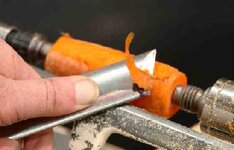WHAT A ROOKIE QUESTION!
Right?????
Well I wanna know. I have been told that it works in a very specific manner, but i have recently watched a couple of turning vids and the person in the vids uses the skew much differently than what i was explained.
How i was told: Toolrest close, and about the same height as for the scraper.. maybe a little lower. Same as all other tools, introduce the bevel first, and ride the bevel as the skew makes a "knife" type cut on the top of the blank...
How i saw it being used: Toolrest further away, and higher like for a scraper. introduced to the wood edge first in a negative rake type situation.
I am so confused... Seems like the person in the video was maybe doing it wrong? But the person in the video is a pro, so i am confused....
Right?????
Well I wanna know. I have been told that it works in a very specific manner, but i have recently watched a couple of turning vids and the person in the vids uses the skew much differently than what i was explained.
How i was told: Toolrest close, and about the same height as for the scraper.. maybe a little lower. Same as all other tools, introduce the bevel first, and ride the bevel as the skew makes a "knife" type cut on the top of the blank...
How i saw it being used: Toolrest further away, and higher like for a scraper. introduced to the wood edge first in a negative rake type situation.
I am so confused... Seems like the person in the video was maybe doing it wrong? But the person in the video is a pro, so i am confused....

